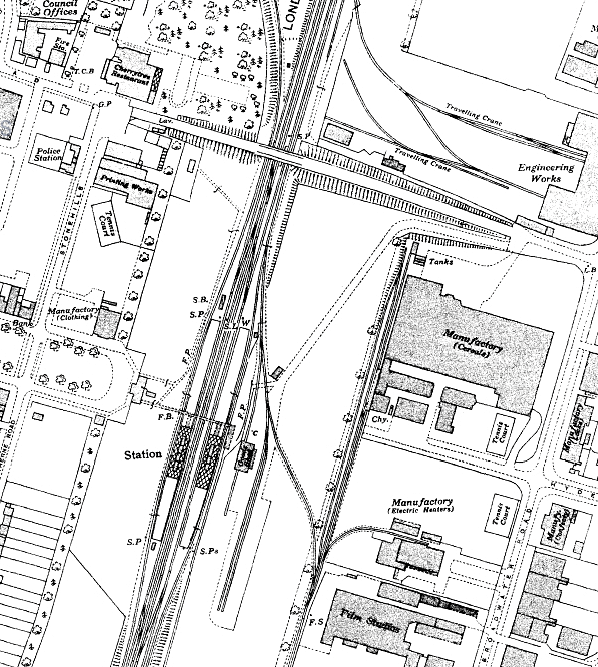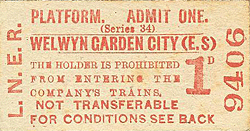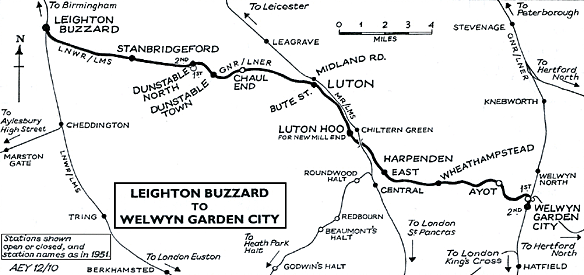
Station Name: WELWYN GARDEN CITY
|
| Date opened: | 20.9.1926 |
| Location: | To the east of the Howard Centre. Access to the station is from inside the Howard Centre. |
| Company on opening: | London & North Eastern Railway |
| Date closed to passengers: | Station still open |
| Date closed completely: | Station still open |
| Company on closing: | Station still open |
| Present state: | Station still open - Dunstable and Hertford line platforms are still in use, |
| County: | Hertfordshire |
| OS Grid Ref: | TL240129 |
| Date of visit: | Not visited |
Notes: When the Hertford North line opened on 1st March 1858, Welwyn Garden City didn't exist. Welwyn Junction station was opened close to the junction. When the second stage of the Dunstable line opened on 1st September 1860, Welwyn Junction closed and both lines made a junction with the GNR with trains running south to Hatfield. In December 1868 new parallel lines into Hatfield were brought into use for the branch line services, and the earlier junctions were removed in January 1869. In 1919, Sir Ebenezer Howard arranged for the purchase of land in Hertfordshire that had already been identified as a suitable site for a new town. On 29th April 1920 his company, Welwyn Garden City Limited, was formed to plan and build the garden city, similar to the one he had founded at Letchworth in 1903. To help with the transport of both workers and building materials to the construction site, temporary wooden platforms were built on both the Dunstable and Hatfield branch lines. The platform on the Dunstable route was actually at the point where it curved away from the Great Northern main line, and it opened on 14th August 1920. The majority of workers commuted from London, and special trains were chartered running from Kings Cross to Finsbury Park then fast to the new platforms.
A modest goods yard with a brick goods shed and several private sidings opened in 1932 on the east side of the station. In 1944 a large marshalling yard was built to the south of the station to help reduce congestion at Hatfield. The goods yard closed on 5th April 1975 although a private siding remained in use after that date. In 1977, new carriage sidings were built to the north of the station on both sides of the line as part of the electrification of the Great Northern main line. The start of the Dunstable branch was used as the connection to these sidings. When the Howard Centre shopping centre was opened in October 1990, the original booking hall was demolished and was replaced with a new booking office inside the Centre, with steps linking down to the original bridge and on to the platforms.
Towards the end of 2007 Welwyn Garden City was awarded 'Secure Station' status, along with many other stations along the Great Northern route as part of a stations improvement programme by First Capital Connect. As part of this award, many additional cameras were installed. On Monday to Saturdays, trains operate half-hourly on First Capital Connect's London to Cambridge/Peterborough line towards London Kings Cross and hourly towards Cambridge and Peterborough respectively. On Sundays there is an hourly service southbound to London and northbound to Cambridge. Welwyn Garden City is a terminus for First Capital Connect's London - Welwyn line stopping service. Trains depart every 20 minutes to Moorgate in London on weekdays, and outside these times every half hour to London Kings Cross. A rail flyover was constructed south of the station to allow the Moorgate trains to arrive and depart from Platform 4. There is also a limited stop service to London Kings Cross at peak times, notably just after 7am where a train runs non-stop to Finsbury Park and 8am where the next stop is Potters Bar. BRIEF HISTORY OF THE LEIGHTON BUZZARD TO WELWYN GARDEN CITY LINE
Nothing was done until 1844 when a meeting was held in Luton. By now there was mounting opposition to the scheme which would have to cut across the 'Great Moor', a large area of undeveloped common land close to Luton. This angered George Stephenson who vowed that Luton would not get a direct railway connection to London as long as he lived. Although the Luton line was not built in Stephenson's lifetime (he died in 1849), a branch line to Dunstable received Royal Assent on 30th June 1845 with the passing of the Dunstable, London & Birmingham Railway Act which authorised a line between Leighton and Dunstable. Inevitably a meeting was held in Luton to discuss proposals from local businessmen to build a line from Luton to the new line at Dunstable once it was completed. Many people preferred a counter proposal for a direct line between London and Manchester passing through Luton, which would be 14 miles shorter for passengers travelling to London, avoiding the need for a change of trains at Dunstable and Leighton. Another option was to build a branch to the Great Northern Railway's London to York line which was already under construction and would pass 12 miles to the east of Luton. The direct route was chosen as the best option which, at that time, left Luton without a railway while other branch lines in the area were already being planned and built.
On 3rd July 1854 the Hertford & Welwyn Junction Railway received parliamentary authority to build a line from the North Eastern Railway at Hertford to the GNR at Digswell, and on 30th September 1854 there was a proposal to extend this line across the GNR to Luton and Dunstable linking three established railway companies (NER, GNR & LNWR). Not wanting to be left out, the GNR offered to work the line between Hatfield and Luton although it was not prepared to provide any finance.
The Luton, Dunstable & Welwyn Junction Railway Act was passed on the 16th July 1855 authorising a junction with the LNWR at Dunstable and a triangular junction with the GNR at Digswell together with a bridge over the GNR to allow through running over the H & WJR between Hertford and Dunstable. All three companies were authorised to work the line. A single track was built (with the intention of doubling in the future) with construction starting on 16th October 1855 which, in Luton, was designated as a half-day public holiday as residents had waited so long to get a railway!
Work on the Luton line had been progressing during the amalgamation negotiations, and at a shareholders’ meeting on 6th August 1857 it was announced that the first section of the line between Luton and Dunstable was ready for goods traffic. Several goods wagons were fitted with seats to take shareholders along the line. The line was initially inspected on 18th March 1858 and, after a turntable was provided at Leighton at the request of the Board of Trade inspector, the line was passed a month later, with a goods service running from 5th April 1858 and a passenger service from 3rd May 1858; large crowds travelled to Luton station for a day to take part in the celebrations and ride on the new line.
In April 1860 the HL & DR informed both the Eastern Counties Railway and the GNR that they were ending the 1858 agreement. The GNR immediately took steps to take over the line because of its strategic importance as a link between the three main lines; a Parliamentary Bill was prepared to facilitate this. At this time the line was nearing completion, with a special train carrying LNWR officials on 12th June and another 'special' on 17th July for company shareholders. After passing its Board of Trade inspection, the line between Luton and the Great Northern was opened to both goods and passenger traffic on 1st September 1860 with intermediate stations at New Mill End, Harpenden and Wheathampstead. At this time a Sunday service was introduced for the first time. There was a junction with the GNR at Welwyn, but no station was provided, and the H & WJR station at Welwyn Junction was closed with trains on both lines terminating at Hatfield. In 1864 there were six daily down trains between Hatfield and Leighton, with five up trains. There were a further two down trains between Luton and Leighton in the early morning with two up trains in the afternoon and evening and one train in each direction between Hatfield and Dunstable. On Sundays there were two down trains between Hatfield and Dunstable, with one up train with two short-running services.
Although built as single track throughout, it was always the intention that the line would be doubled, and sufficient land was acquired over some of the route. In the late 1890s the Great Northern line between Digswell and Hatfield was widened with a new track being provided for Dunstable trains, and the old Dunstable line becoming the new down slow main line In 1890 passenger numbers were sufficiently high for doubling the line between Luton and Dunstable. This was authorised by Parliament in 1891, but progress was slow and it did not open until 10th September 1899. Proposals to double the remainder of the line brought a lukewarm response from the GNR. Passenger numbers increased through the 1890s, and by 1900 there were nine trains in each direction between Luton and Dunstable, with eight in each direction between Luton and Dunstable and seven between Dunstable and Leighton.
Through the 20th century the line remained very profitable, due in part to the large number of private sidings, in particular those serving chalk quarries near Dunstable, the sand and gravel pits around Leighton Buzzard and, later, Vauxhall Motors in Luton. Following the 1923 general grouping the Dunstable branch became part of the London Midland & Scottish Railway while the Hatfield to Dunstable line was part of the London & North Eastern Railway. This split continued after nationalisation in 1948 with British Railways Eastern Region being responsible for the Hatfield line as far as Harpenden down distant signal, with the remainder of the line coming under the London Midland Region. On 2nd April 1950 the boundary was adjusted, transferring Harpenden (East added on 25th September 1950) to the LMR. Diesel-hauled freight trains started replacing steam in February 1959, and passenger trains in June 1959, the latter being replaced with DMUs in 1962.
The line remained open for freight traffic until 1st January 1966 after which it was cut back to Grovebury sidings south of Leighton Buzzard, serving sand and gravel pits, until final closure on 5th December 1969. Track-lifting was piecemeal, starting at Dunstable in late 1968 but not reaching Stanbridgeford until July 1969. Track-lifting west of Stanbridgeford started in February 1970 and was not completed until February 1971. National Cycle Route 6 now follows what is now known as the Sewell greenway between Stanbridgeford and Dunstable.
The Hatfield line was scheduled to close on 6th January 1965 as part of the Beeching cuts. Closure was deferred following local objections - but only until 24th April when the last 'Skimpot Flyer' carried a wreath and a large number of passengers on a farewell journey along the line: it returned to Hatfield almost empty! The line remained open for freight and for goods traffic to Luton Bute Street until 26th June 1967. After that date the line between Luton and Dunstable was singled and retained to serve the Dunstable Cement works at Houghton Regis, with a new connection from the Midland main line at Luton opening in November 1965. The east end of the line was also retained for rubbish trains bound for Blackbridge sidings east of Wheathampstead. Track lifting on the remaining section between Blackbridge and Luton started at the Eastern Region/London Midland region boundary west of Harpenden East station on 8 May 1966 towards Luton and from 26th February 1967 towards Blackbridge. Blackbridge sidings closed in May 1971, and much of the track between Welwyn Garden City and Wheathampstead now forms the Ayot Greenway cycleway and footpath, with the the trackbed between Luton Hoo and Harpenden is incorporated into the 50-mile Lee Valley Walk.
In December 2003 the Department for Transport approved the Transport & Works Act submission for a £85m scheme to convert the line into a guided busway. Planning permission and a Transport & Works Order were granted in November 2006, and the Transport Minister gave the go-ahead in August 2008. Tenders for its construction were sought in July 2009.
Sources: Wikipedia (Leighton Buzzard station) and the Hatfield, Luton & Dunstable Railway by G & S Woodward (1977). Published by Oakwood Press ISBN 978-0-853614-58-6. For further reading see Hertfordshire's lost railways by Keith Scholey ISBN ISBN 1 84033231 X and Bedfordshire's lost railways by Keith Scholey ISBN ISBN 184033 271 9 and Branch Line to Dunstable by Sue & Geoff Woodward (2008) Published by Middleton Press ISBN 978-1-906008-27-7. Other web sites: Lost lines - features photos taken along the line between 1989 - 2007. BBC Beds, Herts & Bucks web site. Disused Railways web site. Click here to see an aerial view of the whole Leighton Buzzard - Dunstable line on Google Earth. All the stations are shown. Prepared by Mark Percival. Tickets from Michael Stewart , route map drawn by Alan Young, BR timetable from Alan Young, To see other stations on the Leighton Buzzard - Welwyn Garden City line click on the station name: Leighton Buzzard, Stanbridgeford, Dunstable North, Dunstable Town, Chaul End, Luton Bute Street, Luton Hoo, Harpenden East, Wheathampstead, Ayot & Welwyn Garden City Halt To see other stations on the Hertford North - Welwyn Garden City line click on the station name: Welwyn Junction, Attimore Hall Halt, Hatfield Hyde Halt, Cole Green, Hertingfordbury & Hertford North |
||||||||||||||||||||||||||
garden_city_old1.jpg)
Copyright photo from John Alsop collection

1878 1:2500 OS map. The junction with the Dunstable line is shown but there were no stations there at this time.


.
garden_city_old4.jpg)
Copyright photo from Stations UK
)garden_city_old10.jpg)
Photo by David Pearson
garden_city_old12.jpg)
Photo by David Pearson
garden_city_old5.jpg)

Photo by by Peter Skuce reproduced from Wikimedia Commons under creative commons licence
| Last updated: Friday, 26-May-2017 09:56:57 CEST |
© 1998-2011 Disused Stations
|














garden_city_old_thumb3.jpg)
garden_city_old_thumb2.jpg)
garden_city_old_thumb4.jpg)
garden_city_old_thumb6.jpg)
garden_city_old_thumb7.jpg)
garden_city_old_thumb8.jpg)
garden_city_old_thumb9.jpg)
garden_city_thumb1.jpg)

 Home Page
Home Page